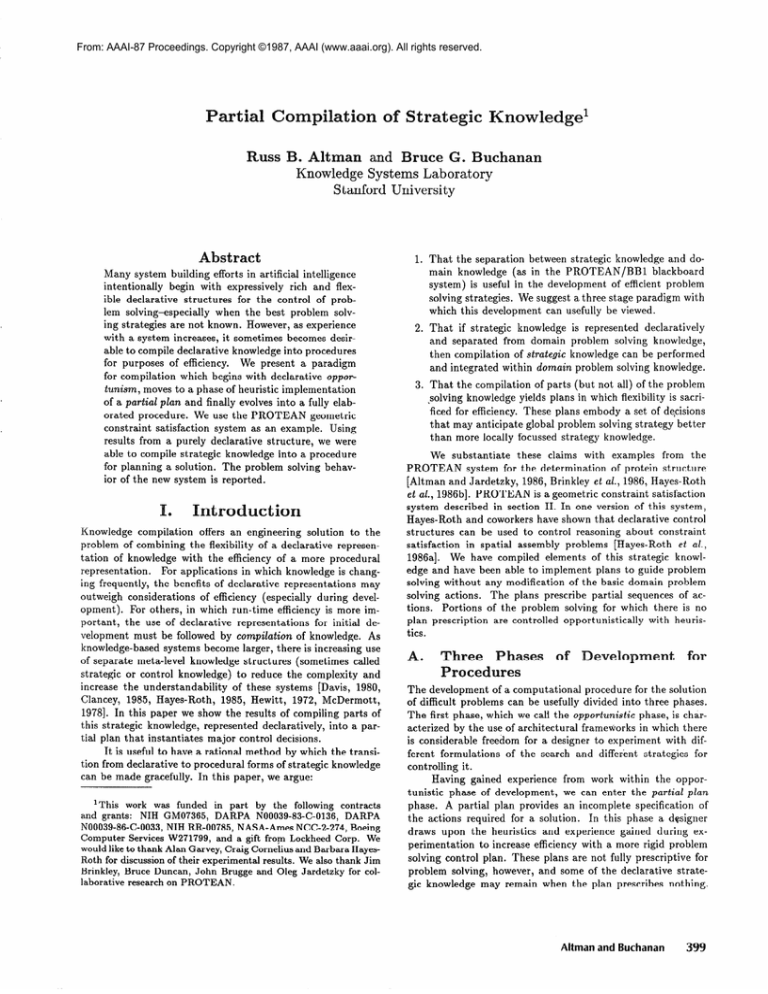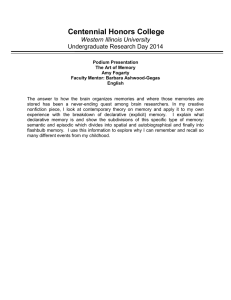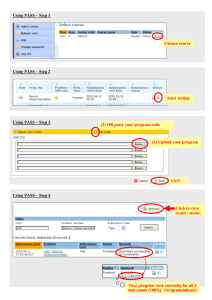
From: AAAI-87 Proceedings. Copyright ©1987, AAAI (www.aaai.org). All rights reserved.
Partial
Compilation
Russ
of Strategic
Knowledge1
B. Altman
and Bruce 6. Buchanan
Knowledge Systems Laboratory
Stanford University
Abstract
Many system building efforts in artificial intelligence
intentionally begin with expressively rich and flexible declarative structures for the control of problem solving-especially when the best problem solving strategies are not known. However, as experience
with a system increases, it sometimes becomes desirable to compile declarative knowledge into procedures
for purposes of efficiency. We present a paradigm
for compilation which begins with declarative opportunism, moves to a phase of heuristic implementation
of a partial plan and finally evolves into a fully elaborated procedure. We use the PROTEAN
geometric
constraint satisfaction system as an example. Using
results from a purely declarative structure, we were
able to compile strategic knowledge into a procedure
for planning a solution. The problem solving behavior of the new system is reported.
Knowledge compilation offers an engineering solution to the
problem of combining the flexibility of a declarative representation of knowledge with the efficiency of a more procedural
representation. For applications in which knowledge is changing frequently, the benefits of declarative representations may
outweigh considerations of efficiency (especially during development). For others, in which run-time efficiency is more important, the use of declarative representations for initial development must be followed by compilation of knowledge. As
knowledge-based systems become larger, there is increasing use
of separate meta-level knowledge structures (sometimes called
strategic or control knowledge) to reduce the complexity and
increase the understandability of these systems [Davis, 1980,
Clancey, 1985, Hayes-Roth, 1985, Hewitt, 1972, McDermott,
19781. In this paper we show the results of compiling parts of
this strategic knowledge, represented declaratively, into a partial plan that instantiates major control decisions.
It is useful to have a rational method by which the transition from declarative to procedural forms of strategic knowledge
can be made gracefully. In this paper, we argue:
‘This work was funded in part by the following contracts
and grants: NIH GM07365, DARPA N00039-83-C-0136,
DARPA
N00039-86-C-0033, NIH RR-00785, NASA-Ames NCC-2-274, Boeing
Computer Services W271799, and a gift from Lockheed Corp. We
would like to thank Alan Garvey, Craig Cornelius and Barbara Hayes-
Roth for discussionof their experimental results. We also thank Jim
Brinkley, Bruce Duncan, John Brugge and Oleg Jardetzky for collaborative research on PROTEAN.
1. That the separation between strategic knowledge and domain knowledge (as in the PROTEAN/BBl
blackboard
system) is useful in the development of efficient problem
solving strategies. We suggest a three stage paradigm with
which this development can usefully be viewed.
2. That if strategic knowledge is represented declaratively
and separated from domain problem solving knowledge,
then compilation of strategic knowledge can be performed
and integrated within domain problem solving knowledge.
3. That the compilation of parts (but not all) of the problem
-solving knowledge yields plans in which flexibility is sacrificed for efficiency. These plans embody a set of decisions
that may anticipate global problem solving strategy better
than more locally focussed strategy knowledge.
We substantiate these claims with examples from the
PROTEAN
system for the determination of protein structure
[Altman and Jardetzky, 1986, Brinkley et al., 1986, Hayes-Roth
et al., 1986131.PROTEAN
is a geometric constraint satisfaction
system described in section II. In one version of this system,
Hayes-Roth and coworkers have shown that declarative control
structures can be used to control reasoning about constraint
satisfaction in spatial assembly problems [Hayes-Roth et al.,
1986a]. We have compiled elements of this strategic knowledge and have been able to implement plans to guide problem
solving without any modification of the basic domain problem
solving actions. The plans prescribe partial sequences of actions. Portions of the problem solving for which there is no
plan prescription are controlled opportunistically with heuristics.
A.
Three
Phases
Procedures
of
evelspment
for
The development of a computational procedure for the solution
of difficult problems can be usefully divided into three phases.
The first phase, which we calf the opportunistic phase, is characterized by the use of architectural frameworks in which there
is considerable freedom for a designer to experiment with different formulations of the search and different strategies for
controlling it.
Having gained experience from work within the opportunistic phase of development, we can enter the partial plan
phase. A partial plan provides an incomplete specification of
the actions required for a solution. In this phase a designer
draws upon the heuristics and experience gained during experimentation to increase efficiency with a more rigid problem
solving control plan. These plans are not fully prescriptive for
problem solving, however, and some of the declarative strategic knowledge may remain when the plan prescribes nothing.
Altman and Buchanan
399
Partial
Plans
Re
Compile
Strategic
Knowledge
I
I
Figure
1: Three suggested stages in the development
of
The transition
from declared strategies
to
strategies.
more procedurally
defined ones involves the compilation
of strategic knowledge.
The plans provide more direction and purpose to the problem
solving than strategies with a shorter horizon. Thus, a plan
imposes a particular detailed set of steps on problem solving
and so reduces the amount of computational effort spent on
choosing among different choices.
Experimentation with a system in the partial plan stage
may lead to refinement of the plan details. We believe, but have
not shown, that compilation of strategy knowledge can be automated when the syntax of both the declarative strategy knowledge and the domain knowledge structures is known. When the
plan becomes fully elaborated it can be called a heuristic procedure for solving the problem. The procedure phase requires
little computational effort in choosing control alternatives-all
decision points are predefined and the criteria for selection are
predetermined. We have found that this computational saving
comes at the cost of problem solving flexibility.
B.
Compilation
of Knowled
In a changing, experimental setting it is useful to represent
strategy heuristics with declarative data structures in order
to provide an environment for experimentation with different
strategies. However, when there is evidence that certain strategies are superior to others, it may become desirable to incorporate these strategies more directly,into the solution for efficiency.
Compilation of declarative strategic knowledge is characterized by a move from a description of desirable actions
to prescriptions for action. Systems which allow descriptive strategic statements are faced with the task of interpreting
these statements and matching them with feasible actions in
order to identify desirable actions [Hayes-Roth et al., 1986a].
Davis [Davis, 19801ref erred to the interpretation of such metalevel strategic statements as content-directed invocation. However, the cost of using generic control statement interpreters
and action-matchers may not be warranted if there is a procedure which can identify the most desirable actions using specific domain knowledge. Such a procedure bypasses the use
of all-purpose interpreters and matchers, and thereby improves
efficiency.
We have manually constructed special-purpose, domaindependent procedures for making strategic decisions in situations for which criteria have become clear from experimentation. These procedures eliminate the need for interpretation of
control strategies and the overhead of matching these strate-
400
Knowledge Representation
gies with potential domain actions. They gain problem solving
leverage by using knowledge of the application domain, and as
such can be considered domain problem solving actions. The
key step in compilation is creation of a partial plan, an abstract
sketch of how to solve the whole problem which is stylized
enough to allow straightforward translation into procedures.
We do not assume that the plan is complete, however, and thus
must abe able to solve problems with partially compiled, partially interpreted control strategies. Our procedures, therefore,
produce a partial plan for the solution of the problem. Section II shows how the ideas apply to PROTEAN.
Section III
illustrates how this plan interacts with data driven control for
a particular problem.
A.
The
PROTEAN
System
PROTEAN
is a system for determining the structure of protein
molecules from experimental data. The system and motivations
are described in detail in [Altman and Jardetzky, 1986, Brinkley
et oI., 1986, Hayes-Roth et al., 1986131,but are summarized for
present purposes. PROTEAN
begins with a number of abstract
or elementary objects (atoms or groups of atoms with fixed
physical relationships) and constraints among the objects. A
constraint typically specifies a range of distances between two
points.
PROTEAN
makes “partial arrangements” of subsets of
the objects in three dimensions, and then combines partial arrangements into a final solution space. In a single partial arrangement, a coordinate system is defined around a single object (called the anchor), and positions of other objects (alachorees) relative to the anchor are defined (see Figure 2). Except for the anchor, an object may have more than one “legal
location” in which its positional constraints are satisfied. A
“coherent instance” is a list of single locations for each object
such that all constraints are satisfied. The set of all coherent
instances represents the set of all structures of the protein that
are consistent with the experimental constraints.
PROTEAN
has a basic set of actions that have been procedurally defined within domain problem solving knowledge
sources. They include:
ANCHOR [B to A]: finds all locations for anchoree B relative to anchor A (in a partial arrangement) which are
consistent with the constraints between A an B. Figure 2
shows the accessible volume of two anchorees relative to a
fixed anchor (HELIX-5).
YOKE [B and C with respect to A]: reduces the list of
locations of anchorees (B and C) in the space of anchor A by pruning locations that are incompatible with
the constraints between B and C. Figure 3 shows Helix-3
and Helix-l after YOKING. Their accessible volumes have
been reduced by consideration of the constraints between
them (cf. Figure 2).
APPEND
[C to B with respect to A]: finds all locations of
object C relative to an anchoree B in the space of anchor
A. This involves finding all locations of C relative to B and
B relative to A and then producing the cross product to
get all locations of C relative to A. Figure 3 shows Helix-
2 positioned with an APPEND
constraints to Helix-3.
action by considering its
CDCONSOLIDATE
[o bj ec t s with respect to A]: finds the set
of locations (one from each object’s accessible volume) that
constitute a “coherent instance.”
which is triggered when a relevant change is made to the problem solving (“domain”) blackboard. A triggered KS is instantiated as a Knowledge Source Activation Record (KSAR) for
each context in which the action becomes feasible, and is placed
on the agenda. Domain Knowledge Sources are generally procedural statements of how to perform calculations and make
appropriate changes on the problem solving blackboard. A separate control facility is then used to rate feasible actions and
determine which actions should be performed.
Anchor
0
Con&rolling
The problem of arranging objects in three dimensional space
under constraints is known as bin packing, and is NP-complete.
PROTEAN
is able to solve such a combinatorially explosive
problem partly because it can make reasoned choices about the
best objects and best actions on which to focus at each stage
of problem solving. The strategic choices that must be made
by PROTEAN
include:
1. How many partial arrangements should be created?
2. Which objects should be included in the partial arrangements?
Figure 2: PROTEAN’s
basic problem solving action, ANCHOR. Legal
- locations are shown as accessible volumes
around each anchoree.
3. Which objects should be designated the anchors of the
partial arrangements?
4. Should an ANCHOR or APPEND
actions be used to position a particular object within an arrangement?
5. In what order should YOKE actions be applied to most
quickly reduce the size of the accessible volumes?
6. When are two partial arrangements ready to be merged
toget her?
7. When should a partial arrangement be CONSOLIDATED
(because pruning techiques have reaced a point of diminishing returns)?
Figure
3:
YOKE
and APPEND.
PROTEAN’s
b asic problem
solving
actions,
A partial arrangement can be considered a constraint satisfaction network in which each node is an object with a list
of locations and each arc between nodes represents constraints
on the relationships between pairs of locations taken from the
nodes. We have shown elsewhere [Brinkley et al., 19861 that
the anchor action corresponds to creating a constraint network
that is node consistent in the terminology
- of Mackworth [Mackworth, 19771. Yoking corresponds to checking for consistency
of the arcs. Consolidation is equivalent to a backtrack search
for solutions to the constraint-network.
Backtrack search is
computationally prohibitive, and it can be made tractable by
pruning the set of initial locations with anchor and yoke operations. PROTEAN’s
problem solving repertoire of four primitive actions has been implemented as a set of domain knowledge
sources in the BBl blackboard environment [Hayes-Roth, 19851.
Each action is represented as a domain Knowledge Source (KS)
In addition to our continued development of an explicit,
declarative version of the strategy, there is a need for a systematic compilation of the method. Thus, part of our research focuses on the development of a straightforward procedural statement of how to make these choices, which in BBl are called
“control problems.”
The key characteristic of this implementation of PROTEAN in BBl is that there is a separation of the mechanism
which generates feasible actions from that which selects actions
for execution. When a control problem arises, the system can
look to the agenda of feasible actions for a complete set of alternatives, and choose among them. The process of compilation of
strategic decisions reduces the frequency at which the complete
agenda must be examined.
The ACCORD language has been developed to define high level
“control sentences” which declaratively and indirectly specify
problem solving actions [Hayes-Roth, 19851. For example, in
choosing the best anchor for a partial arrangement, one cqntrol
sentence reads:
ORIENT
a PARTIAL-ARRANGEMENT
about a
LONG, RIGID, CONSTRAINING
SECONDARYSTRUCTURE.
Altman and Buchanan
401
This sentence is interpreted and matched with each task on
the agenda (called a KSAR) in order to determine an overall
rating for the task. The “action-type” of the KSAR is compared and scored relative to the action-type ORIENT,
the
potential anchor is checked and scored with respect to being
a SECONDARY-STRUCTURE
as well as being LONG,
RIGID
and CONSTRAINING.
The definitions of these
modifiers are stored in a knowledge base as quantitative rating
functions. The KSAR action that best matches this declaration
is chosen for execution.
This control mechanism is flexible since it can handle a
wide variety of problems, and be used for explaining its selection [Schulman and Hayes-Roth, 19871. It also allows different
modifiers to be easily tested and results to be compared [Garvey et al., 19871. I n short, it is convenient for experimenting
to find specific rules for solving classes of problems. It is expensive, however, since each potential anchor must be rated
with respect to a number of different modifiers. In addition,
it takes a best-first approach to control, and assumes that optimal decisions locally will produce good global performance.
Each control sentence is meant to choose the next step in the
solution. A control sentence can not decide that a sequence
of steps should be pursued, but can only select a single step.
Therefore, this approach ties the program down to an extremely
“deliberate” control process.
A second method of control that we have implemented
for PROTEAN
incorporates experimental results with control
sentences and imposes more structure on the problem solving
sequence. The results in [Garvey et al., 19871showed that certain modifiers in the control sentence were more important than
others, and usually led to better performance. For instance, in
the case of selecting an anchor, the number and distribution
of constraints to other objects is the most important variable
(as captured by the modifier CONSTRAINING).
We compiled this rule into a new knowledge source which procedurally
defined the criteria for choosing an anchor by examining properties of the initial constraint network. We used similar results
from our own studies to compile a procedure for deciding which
objects should be introduced into a partial arrangement with
the ANCHOR
action versus the APPEND
action. We added
this information to the new knowledge source and were left with
a domain problem solving KS which chooses the best global
anchor, the best anchorees to introduce into the global partial
arrangement as well as other “secondary” partial arrangements
with which to define local geometries.
This KS, therefore, produces a partial plan for solution
of the problem (shown in Figure 4). As a result of compiling PROTEAN’s
declarative control sentences, Helix-5 can be
uniquely identified without further search to be the anchor. In
addition, Helices 1,3,8,9 and 10 are designated as anchorees.
Other objects are to be introduced into the space of Helix-5
with an APPEND
action. In order to implement this plan, we
also added a single control statement that favors KSARs mentioned in the plan. This control statement simply checks to
see if the KSAR appears in the plan or not, and replaces other
control declarations (like the ORIENT control sentence shown
previously) that require interpretation and matching. Our plan
allows us to remove control sentences that address control issues 1,2,3 and 4 as listed in section II-B. Three points should
be emphasized:
1. Our method for compilation has two steps:
402
Knowledge Representation
Helix-3
Figure
solution
4:
A graphical
Mix-9
depiction
Helix-lo
othsr-i -Bnchoree~
of the partial
plan for
of T4 Lysozyme.
(a) Manual
(b)
Helix-8
Static
Compilation
Reformulate declarative strategic knowledge (derived from experimentation) into domain procedures for solving a problem. These procedures are
contained in new domain knowledge sources and
specify the compiled criteria for choosing objects
and actions during problem solving.
Replace all reformulated declarative strategic
knowledge with a single strategic statement that
chooses domain actions mentioned in the plan
whenever they become executable.
Dynamic
Compilation
in Context Execute the
procedure in the context of a problem statement in
order to actually select objects and actions that constitute a partial plan for solution. The instantiated
plan is used to guide control decision making.
2. By compiling strategic knowledge, we have decided to
make some control decisions in advance. The “compiled”
decisions are based on evaluation of the static properties of
the objects in the problem and the domain problem solving actions. They should not depend critically on dynamic
properties of the problem. If unanticipated problems occur
in implementation of the plan, this decision may prove to
be extremely expensive. It is therefore important to have
confidence in the declarative strategic sentences that are
compiled. In our compilation of knowledge we have not
altered any of the other knowledge sources for problem
solving; we have just added one domain KS for planning,
and a control declaration that requires KSARs that implement the plan to be executed before others. Thus, the
compilation step is modular, relatively non-destructive to
system integrity, and decreases the number of declarative
sentences that must be interpreted and matched.
3. Having an overview of the global solution strategy also offers opportunities which are not available without a plan.
For example, the plan produced by our procedure immediately suggests subtasks for parallel execution. Each of
the secondary partial arrangements of Figure 4 represents
an independent constraint network that can be brought to
equilibrium in isolation from the others.
When the plan is produced and instructions for following the plan are added, the nature of control changes significantly. The issue of choosing an anchor, for example, is not a
significant control issue any longer: it has been moved into the
procedural detail of a problem solving knowledge source. However, the exact order in which to perform YOKE operations
still remains unresolved. Thus, the selection of feasible yoking
actions has been left in a declarative, opportunistic framework.
The plan thus leaves significant details (i.e., the order of yokes)
unresolved until run-time interpretation of control knowledge
sources, while fixing some details in the compiled steps. When
all such strategy knowledge has been compiled into domain
knowledge, then the strategy becomes procedurally defined by
the sequence of these domain knowledge sources and there is
little flexibility for testing alternative strategies.
objects have strong constraints to distant objects. It is clear
that the strategy decisions outlined in section II-B are not obvious, and require reasoning and analysis of the network.
A trace of the problem solving behavior of PROTEAN
is
useful in understanding how strategic reasoning and domain actions combine to produce useful problem solving behavior. For
any given cycle, BBl may follow a compiled decision to follow
the plan (Dl), may reason out a strategic decision about the
best action (D2), or may perform the domain actions specified
by Dl or D2 (A).
TYPE OF REASONING
DECISIONS/ACTIONS
------_--------_------------------------------------------------------CONTROL
Decides
to Run the KS which
examines
the
0
(01)
CYCLE
problem
In order to illustrate the behavior of PROTEAN
using a solution plan, we present the results of the method when applied to
the protein phage T4 Lysozyme. PROTEAN
processes its input
to define 37 superatoms into which the protein can be divided
(as suggested by experimental data). In addition, PROTEAN
creates a constraint set for each pair of objects between which
there are distance constraints. Not all objects have constraints
with other objects, so there is a total of 119 constraint sets (out
of the total possible (372 - 37)/2 = 666). A graphical depiction
of the constraint matrix is shown in Figure 5.
and
produces
a plan.
1
DOMAIN
(A)
Plan algorithm
is run, HELIX5
is chosen
the anchor,
12 objects
are designated
anchorees.
and 14 objects
are designated
appendees
(See Figure
4).
2
CONTROL
(Dl)
Decides
to implement
the plan from cycle
by automatically
favoring
KSARs which
directly
implement
pieces
of the plan.
3-30
DOMAIN
(A)
Partial
Arrangement
and oriented
around
introduced
into PA1
31
CONTROL
(D2)
Decides
to YOKE accessible
volumes
determined
in previous
cycles.
NOTE: there
is no plan
specification
for this, so it is done
opportunistically
with declarative
control.
32-110
DOMAIN
(A)
YOKES
are favored
between
objects
that are
LARGE,
have STRONG
constraint
sets,
and have
GIG-RELATIVE-DIFFERENCE
in the size of their
location
tables.
They continue
until
the
constraint
network
within
the partial
arrangement
reaches
equilibrium.
111
CONTROL
(Dl)
Decides
to establish
the secondary
anchor
spaces.
ORIENTed
around
the secondary
anchors
as specified
by the plan, and ANCHOR
the
appendees
as specified.
112-200
DOMAIN
(A)
Carries
out plan for secondary
partial
arrangements
by ANCHORing
appendees
to
secondary
anchors.
201
CONTROL
(02)
Decides
to YOKE
order to reduce
202-240
DOMAIN
(A)
Opportunistically
241
CONTROL
(Dl)
Decides
to APPEND
appendees
as specified
by the plan.
into
PAl.
appendees
as
1
1 (PAl)
is established
HELIXI.
Anchorees
are
and ANCHORed
to HELIXB.
objects
location
YOKES
into
in secondary
table
size.
PAS
in
objects.
main
main
241-250
DOMAIN
(A)
APPENDS
251
CONTROL
(02)
Decides
to continue
YOKING
new location
tables
in PA1 with previously
yoked
location
tables
from cycles
32-110.
252-400
DOMAIN
(A)
YOKES
opportunistically
until network
equilibrium
is reached
and all location
tables
are at minimum.
At this point,
backtrack
search
CONSOLIDATION
can be
performed.
PA1
.--------------------------------------------------------------------bC000000
13
00000
0 0 13 Q
00 a 0
0
0 0 0
0000000000
0800000000000000
0 0
0
0 0
88
T4 Lysozyme
Figure 5: Matrix
depiction
0
Constraint Network
of the constraint
network in T4
Lysozyme.
The objects occur in chemically linked sequence and are
numbered 1 to 37, from left to right and top down. The approximate strength of the constraint set, Cij, is indicated by
the size of the spot at matrix position ij (or ji).
The constraint rows for key subunits are labelled. The matrix shows
two large clusters of constraints in this system. There are generally strong constraints between neighboring subunits, but few
About half of the control decisions are compiled in this
example, and about half the resulting domain actions follow
directly from them, rather than by interpreting and matching
high level predicates. The plan shown in Figure 4 is partial because there are significant numbers of reasoning cycles in which
it makes no prescription for action (cycles 32-110, 202-240, and
252-400), and “best first” strategies must be used. However,
the structure imposed on problem solving by the initial plan is
strong enough to provide a clear procedural outline. We can
continue to use a purely declarative control structure for testing
and improving the plan if weaknesses are discovered.
Full descriptions of BBl, PROTEAN
and our initial control
strategies can be found in [Altman and Jardetzky, 1986, Brinkley et al., 1986, Hayes-Roth, 1985, Hayes-Roth et al., 1986131.
The theme of transformation from declarative to procedural
specification arises in many artificial intelligence programming
Altman and Buchanan
403
efforts. Our work stresses the usefulness of the partial plan as
an intermediate step.
The EMYCIN system contains a rule compiler that maps
domain rules into a decision tree [van Melle, 19801. The decision tree is a fully elaborated plan for solution of the problem,
and as such corresponds to the final stage or our three-phase
paradigm. EMYCIN
has a static view of how to control evidence gathering (goal-driven, backward chaining). We argue
that an intermediate step of compiling control knowledge into
domain rules before production of such a decision tree provides
a greater flexibility in the development of procedures, since the
control strategies used need not be static. HERACLES
is an
example of another system which uses declarative representations of strategies, and thus could benefit from an intermediate
stage of control compilation [Clancey, 19851. Similarly, metaknowledge used by systems such as PLANNER’s
rule filters
[Hewitt, 19721 or NASL’s choice rules [McDermott, 19781 can
be compiled into domain rules to gain efficiency at the expense
of flexibility.
Skeletal planning was characterized by Friedland in the
MOLGEN work [Friedland, 19791. Our work uses many of the
ideas of heuristic application of a global problem solving strategy. Our plans are partial with respect to the complete sequence
of problem solving, but are not generalized to higher level concepts (i.e., they are expressed in the the low level vocabulary of
domain actions). In that respect they are similar to Schank’s
scrippts,but are part&Z scripts [Schank and Abelson, 19751.
v.
Conchsions
The PROTEAN
system for geometric constraint satisfaction
in the domain of protein structure provides an excellent forum
in which to experiment with different strategies. Others have
formulated declarative strategies, and we have described here
a compilation of parts of these strategies into domain problem solving actions. The compilation of strategic knowledge
has lead to a partial plan which focuses problem solving and
requires less control deliberation. The plan has been used to
determine the structure of T4 Lysozyme, and provides a framework for expansion of the procedural element of strategic reasoning in the future.
Our method works well in domains in which nearly independent strategic decisions can be identified prospectively.
Context dependent decisions can be made opportunistically at
run time since we perform only partial compilation. This mixture of opportunistic and planned problem solving is especially
powerful in domains such as PROTEAN’s
in which a plan is
useful for solving subproblems but opportunism is required to
recombine or conjoin the solutions to the subproblems.
References
[Altman and Jardetzky, 19861 R. Altman and 0. Jardetzky.
New strategies for the determination of macromolecular
structure in solution. J. Biochem, 100(6):1403-1423, December 1986.
[Brinkley et aZ., 19861 J. Brinkley, C. Cornelius, R. Altman, B.
Hayes-Roth, 0. Lichtarge, B. Duncan, B. Buchanan, and
Jardetzky 0. Application of Constraint Sat&faction Techniques to the Determination of Protein Tertiary Structure.
Technical Report KSL 86-28, Knowledge Systems Laboratory, Stanford University, March 1986.
404
Knowledge Representation
[Clancey, 19851 W.J. Clancey. Heracles: representing procedures as abstract metarules. 1985. To appear in ‘Computer Expert Systems’, M. J. Coombs and L. Bolt, eds.
Springer-Verlag, in preparation.
[Davis, 19801 R. Davis. Meta-rules: reasoning about control.
Artificial Intelligence, 15:179-222, 1980.
[Friedland, 19791 P. Friedland. Knowledge-based Hierarchical
Planning in Molecular Genetics. PhD thesis, Computer
Science Department, Stanford University, September 1979.
Report CS-79-760.
[Garvey et aZ., 19871 A. G arvey, C. Cornelius, and B. HayesRoth.
Computational Costs versus Benefits of Control
Reasoning. Technical Report KSL 87-11, Knowledge Systems Laboratory, Stanford University, February 1987. To
appear in ‘Proceedings of AAAI, 1987’.
[Hayes-Roth, 19851 B. Hayes-Roth. A blackboard architecture
for control. Artificial Intelligence, 26:251-321, 1985.
[Hayes-Roth et al., 1986a] B. Hayes-Roth, A. Garvey, M.V.
Johnson, and M. Hewett. A Layered Environment for Reasoning about Action. Technical Report KSL 86-38, Stanford University, November 1986.
[Hayes-Roth et aZ., 1986b] B. Hayes-Roth, B.G. Buchanan, 0.
Lichtarge, M. Hewett, R. Altman, J. Brinkley, C. Cornelius, B. Duncan, and 0. Jardetzky. Protean: deriving
protein structures from constraints. In Proceedings of the
AAAI, pages 904-909, Morgan Kaufmann Publishers, Inc.,
1986.
[Hewitt, 19721 C. Hewitt.
D escription and theoretical anaZysis using schemata of PLANNER, a language for proving
theorems and manipulating models in a robot. Technical
Report TR-258, AI Laboratory, M.I.T., 1972.
[Mackworth, 19771 A.K. M ac kworth. Consistency in networks
of relations. Artificial Intelligence, 8:99-118, 1977.
[McDermott, 19781 D. McDermott. Planning and acting. Cognitive Science, 2:71-109, 1978.
[Schank and Abelson, 19751 R. C. Schank and R. P. Abelson.
Scripts, Plans, Goals, and Understanding. Lawrence Erlbaum Associates, Hillsdale, NJ, 1975.
[Schulman and Hayes-Roth, 19871 R. Schulman and B. HayesRoth. ExAct: A Module for Explaining Actions. Technical
Report KSL-87-8, Knowledge Systems Laboratory, Stanford University, February 1987.
[van Melle, 19801 W. van Melle. A domain-independent system
that aids in constructing knowledge-based consultation programs. PhD thesis, Computer Science Department, Stanford University, June 1980.




